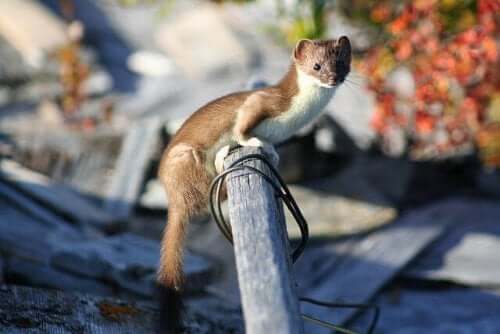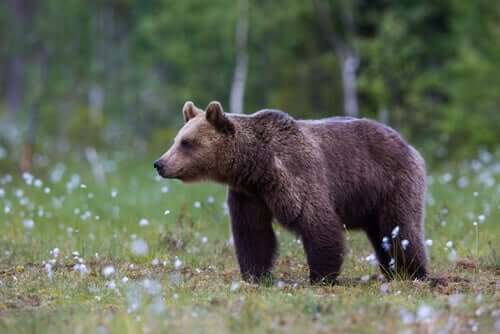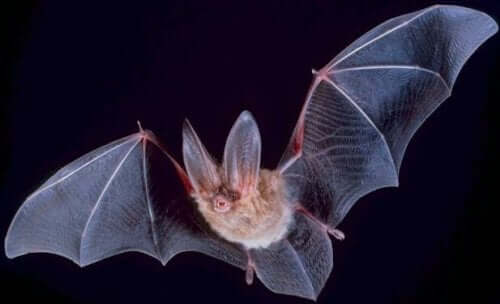6 Different Animals that Live in Caves

Animals can use caves and caverns to hibernate during the winter, or just to sleep during the day. Animals that live in caves are known as troglodytes, or cave dwellers, and they have very special habitats. Discover more about these unique animals in the following article.
The types of animals that live in caves and their habits
While it’s more common for invertebrates to live in caverns, mammals, fish, and reptiles may also choose them as their habitat.
Troglobiants are those cave-dwelling animals that spend the entire day in caves. Other, trogloxenes, come out at some time of the day or year. What’s more, there’s another set of species–troglophiles–that can live both inside and outside of cavernous habitats.
Why do animals choose these places as their homes? Basically, it’s because of the stable environmental conditions they offer in regards to humidity and temperature. Also, caves protect them from predators, allowing them to sleep and to rest without problems. In other words, caves are the perfect place to have offspring because their bodies require darkness in order to survive.
Animals that live in caves have specially adapted metabolisms and body systems. This allows them to inhabit these spaces that contain very little to no light. Over time, some have changed the colors of their bodies and others have lost their sight. Some have even modified their sources of nourishment.
Examples of animals that live in caves
The following species share the special characteristic of being able to survive in caves and caverns:

1. The brown bear
This carnivorous mammal comes from North America and Eurasia and their main habitat is the forest. They live for up to 30 years and measure up to almost 10 feet high. The coloring of the brown bears’ coat of fur varies between light and dark brown. These bears change their fur every summer and don’t have a well-developed sense of sight. However, they can distinguish colors during the night.
Since bears spend their winters hibernating, they choose caves and burrows to hideaway. Here, they can enjoy uninterrupted sleep without their body temperatures varying. When they wake up, they give birth to their young and raise them.
2. Weasels
These mammals live in North America and Eurasia and possess great hunting instincts. Therefore, they can defeat prey that weighs up to ten times as much as they do. As for their morphology, they have a long body and a small snout, large eyes and extremities, and a short tail. Weasels shed their fur in the summer.
These mammals inhabit areas that are far away from human settlements. They prefer rocky caves, but they may also choose piles of logs or fallen trees as their homes.
3. Texas blind salamander
The Texas blind salamander is an amphibian that lives in the caves of Texas and goes by the scientific name of Eurycea rathbuni. These animals don’t contain pigmentation in their skin, which is sensitive to changes in current underwater. They can go up to three months without eating and don’t possess eyes. They detect the movement of their prey, have a flat head, and gills in order to breathe when in water.
Sadly, the number of these animals is constantly decreasing, with only about 100 individuals left.
4. Eurasian eagle-owl
This bird species lives across Africa, Asia, and Europe, and you can find them in a variety of habitats. For example, temperate forests, tundras, steppes, and semi-desert areas. They nest in caves, cliffs, and the former nests of raptor birds. Eurasian eagle-owls are very territorial and live on their own, except during the mating season. They fly directly and glide, and you can hear their voices from over a mile away.
5. Scorpions
Nearly 1400 different species of scorpions exist in the world. One of their main characteristics is that they have stingers at the end of their tails, which they use to inject venom. What’s more, they have arms with pincers on the end. They inhabit rocky and sandy terrains, underground, and in caves that they make for themselves. They are very fast-moving creatures and feed mainly on insects.

6. And last but not least… bats
Of course, when we think about animals that live in caves, the first image that comes to mind is that of a bat. Bats are placental mammals with wings. There are almost 110 different species of these cave-dwelling creatures and they are present all over the world… with the exception of Antarctica. Bats are the only mammals that can fly. These furry fliers play several ecological roles: keeping insect plagues under control, pollinating, and spreading seeds.
Most bats are insectivores and frugivores. They have nocturnal habits and both their noses and their ears allow them to emit and utilize ultrasound, locate food, and know where they are. They live in the cracks and crevices of rocky walls, the bark of trees, as well as in basements, warehouses, and under bridges.
Source of main image: Bering Land Bridge National Preserve
All cited sources were thoroughly reviewed by our team to ensure their quality, reliability, currency, and validity. The bibliography of this article was considered reliable and of academic or scientific accuracy.
- Ibáñez, C. (1998). Los quirópteros. Mamíferos de España. Editorial Planeta SA, Barcelona, 114-218.
- Pacheco, S. M., & Freitas, T. R. (2003). Quirópteros. Livro vermelho da fauna ameaçada de extinção no Rio Grande do Sul (CS FONTANA, GA Bencke & RE Reis, eds.). EDIPUCRS, Porto Alegre, 493-497.
- Méndez, P., Curti, M., Herrera de Montuto, K., & Benedetti, A. (2006). Las aves rapaces. Guía Didáctica de Educación Ambiental. The Peregrine Fund Editorial, Panamá.